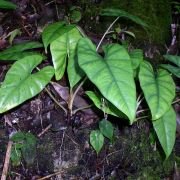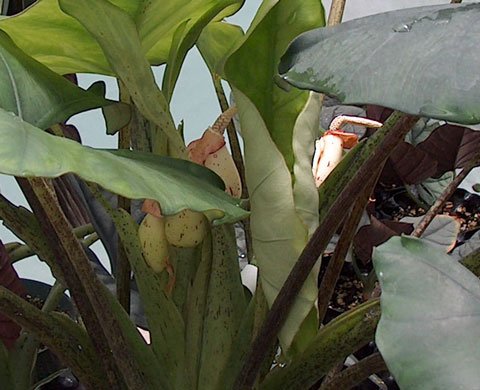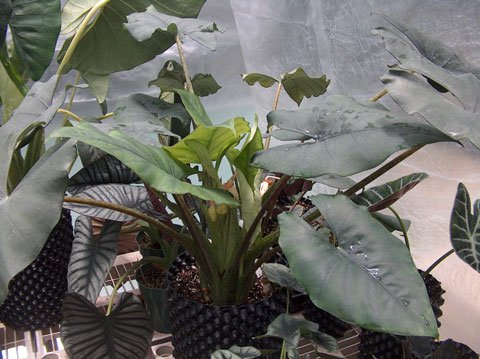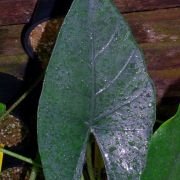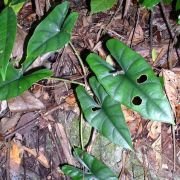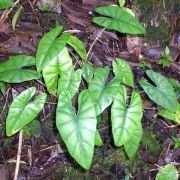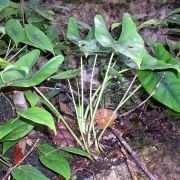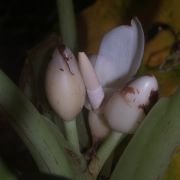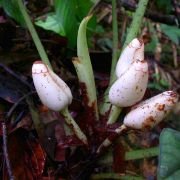ALOCASIA RIDLEYI
ORIGINAL DESCRIPTION:
Ah Alocasia scabriuscula in habitu calcicola, folii lamina plus producta, minus crassa, superne atro-viridi, spatha valde albida vel rosea differt.
TYPUS: Cuh. RBG Sydney Acc. No. 940541 ex Malaysia, Sarawak, Bau, Hay etal. 9388 (NSW, holo; iso, K, KEP, L, SAR, SING (to be distributed)).
[1Alocasia denudata auct. non Engl.: Ridl., J. Straits Br. Roy. Asiat. Soc. 44 (1905) 178.]
SYNONYMS: N/A
DISTRIBUTION: Borneo, restricted to SW Sarawak
CLIMATE: Tropical humid climate
Humidity is moderate throughout the year, ranging from 60% to 70%
Temperature is varies between the seasons - within the range of 48°F/9°C to 88°F/31°C during the day. Minimum temperatures never dip below 45°F/7°C
Rainy and humid season (October to May) and a dry season between June and October. The average annual rainfall is 1,200 mm
ECOLOGY: In forest on limestone at low elevation
SPECIES DESCRIPTION:
Small to robust herb ca. 45-ca. 1 m tall; rhizome 3-6 cm thick; leaves several together; petioles 35-50(-85) cm long, smooth or rarely scabrid, suberect to somewhat spreading, pale green and unmarked or with few to dense purple-brown dots and lines to flushed purple-brown throughout, sometimes with scattered small circular glands, sheathing in the lower ca. 1/5; blade narrowly ovato-sagittate to ovato-sagittate, ca. 15-30(-50) cm long; stiffly leathery, dark green adaxially and shining when young, becoming dull, paler abaxially; anterior lobe widest ca. 2-6 cm distal to petiole insertion; anterior costa with 3-4(-6) primary lateral veins, diverging at ca. 70° (proximal ones) to 50° (distal ones); axillary glands conspicuous (when petiole heavily pigmented) or not (when petiole not so); secondary venation flush on both surfaces, or very slightly prominent abaxially, not or hardly forming interprimary collective veins (these sometimes present in robust specimens); posterior lobes more than V2 to subequalling the length of the anterior, the inner sides narrowly to very narrowly (ob)lanceolate; posterior costae diverging at 60-90°
INFLORESCENCE:
Inflorescences several together; peduncle ca. 8-15 cm long, somewhat exserted from the cataphylls; spathe white to pink, sometimes with purple spots, 7-10(-13) cm long; lower spathe ovoid to pyriform, 2-4 cm long; limb oblong-lanceolate, erect then completely reflexed; spadix somewhat shorter than the spathe, very shortly stipitate for 1.5 mm, 6-9 cm long; female zone 1.5-2 cm; ovaries subglobose, close-packed, ca. 2 mm diam.; style very short, 0.25-0.5 mm long; stigma 2-3-lobed, turning yellowish in spirit; interstice 0.5-1 cm long, slightly attenuate, 4-5 mm diam., composed of 2-3 whorls of more or less close-packed rhombo-hexagonal synandrodia ca. 1.5-2 mm diam.; male zone 1.5-2 cm long, 1/4-V2 within the lower spathe chamber, usually slightly constricted level with the spathe constriction; synandria ivory, rhombohexagonal, ca. 2 mm diam.; appendix tapering, 2-3 cm long, shghtly narrower than male zone, 5-6 mm diam. at base; fruiting peduncle elongating, to ca. 13 cm long; fruiting spathe broadly ovoid, white, sometimes with red spots; longitudinally dehiscent; fruits orange-red.
VARIEGATED FORMS: N/A
ETYMOLOGY: Alocasia ridleyi is named for H.N. Ridley, who took a special interest in Aroids of Borneo (Ridley, 1905), and who was the first to collect this species
NOTES:
1. Alocasia ridleyi is evidently very closely allied to Alocasia scabriuscula, which also has ovato-sagittate leathery leaf blades and narrowly lanceolate posterior lobes. It differs in the very dark green adaxial leaf surface, relatively longer petioles, relatively narrower leaf blades and somewhat more elongate posterior lobes. The leaves are stiffly coriaceous, but are not subsucculent as those of Alocasia scabriuscula often are. The spathe is recorded as white to pink, whereas that of Alocasia scabriuscula is generally greenish white to yellowish, speckled with purple (though the latter feature is sometimes present in Alocasia ridleyi, as indeed it is in several species in this group). In all these respects, this species is somewhat intermediate between Alocasia scabriuscula and Alocasia princeps. These differences seem quite trivial, but they are correlated with a restricted geographic distribution and association with hmestone substrate. Even within its restricted distribution, Alocasia ridleyi exhibits a high level of variability; Nicolson 1285 is xceptionally robust.
Other specimens seen: SARAWAK: Seburan, Bau, Anon. 14596 (K); 1st Division, Bukit Rawan, Tebakang area, Awa & Paie S45245 (K); nr Bau, Bogner 1433 (US); Bau, Brooke 9895 (L), 10797 \bM, L); Bidi Cave, Clemens & Clemens 21920 (BO, K); Cult. RBG Sydney Acc. No. 940545 ex G. Gading, Lundu, Hay et al. 9392 (NSW); Bukit Krian [?= G. Kerian], Madison 7344 (K); Bau limestone hills, G. Setiak (SE of G. Doya), Martin S38666 (K): vicinity of Bau, Nicolson 1285 (L, US); Bau, Purseglove P4467 (GH, K, L, SING); Bau, Ridley 11715 (K, SING); Cult. RBG Sydney Acc. No. 942741 ex Bau, Vogel s.n. (NSW).
CULTIVARS: N/A
HYBRIDS: N/A




